Subsiding Cities: A Case Study of Governance and Environmental Drivers in Semarang, Indonesia
Abstract
1. Introduction
- What are the key significant determinants of subsidence in Semarang, and to what extent do urbanization, groundwater extraction, geology, or all these factors contribute the most?
- How do governance frameworks, policy restrictions, and funding limitations affect the effectiveness of mitigation efforts?
- How do public narratives, stakeholder engagement, and risk perception affect land subsidence adaptation strategies for land subsidence?
- What implications can these findings have for better land subsidence management policies in urban coastal areas?
1.1. Understanding Land Subsidence
1.2. Governance Structures and Policies Related to Land Subsidence
1.3. Geological and Hydrological Setting
2. Materials and Methods
2.1. Study Area
2.2. Methods
2.3. Qualitative Data Collection and Analysis
Quantitative Geospatial Analysis
- a.
- Land Subsidence Analysis using InSAR
- b.
- Land Cover Change Analysis
- Data Acquisition and Pre-Processing: We used the Land Use Land Cover (LULC) dataset from Google Earth Engine (GEE)’s platform (server updated May 2023) together with the JavaScript client library (v0.1.383) and Python API (v0.1.383) for data processing and visualization [80], which provides 10-meter spatial resolution maps derived from Sentinel-2 imagery using a deep learning-based classification approach. This dataset was selected for its high temporal (available for 2017, 2019, 2021, and 2023) and spatial resolution, which is suitable for detecting detailed changes in urban land cover. The GEE LULC dataset offers a pre-processed and validated product, reducing the need for extensive in-house pre-processing [81,82,83].
- Processing and Classification: The LULC data were classified into seven distinct land cover classes: built area, crops, trees, rangeland, flooded vegetation, bare ground, and water. The primary analytical focus was on the change in the built area class over the study period, which was processed using ArcGIS 10.8 software. We used the “Change Detection Wizard” tool in ArcGIS to quantify the area of land converted from other classes to built-up areas between the different time steps (e.g., 2017 to 2023).
- Post-Processing and Validation: The LULC change maps were post-processed through a combination of visual interpretation and a formal accuracy assessment [21,84]. We validated the GEE LULC data by comparing it with high-resolution reference maps from Google Earth and other geospatial datasets. A random sample of 250 points was used to calculate the overall accuracy and Kappa coefficient of the LULC classifications, confirming the data’s reliability for change detection analysis. This step ensures that our change detection results are based on a reliable and validated land cover classification.
2.4. Data Integration and Analysis
3. Results
3.1. Anthropogenic Activities and Urbanization
3.2. Natural Processes and Geological Factors
3.3. Land Use Change and Urban Expansion
3.4. Increased Flood Risk: An Integrated Analysis of Physical and Human Factors
3.5. Stakeholder Perspectives and Conflicting Narratives
3.6. Local Stakeholders’ Perspectives on Land Subsidence Using the Proxy of Floods
- Technical shortcomings: Interventions like road elevation have unintended consequences, exacerbating flooding in residential areas.
- Institutional mismatches: There is a clear conflict between national interests (protecting highways) and local needs, leading to misaligned flood management efforts.
- Organizational capacity gaps: The focus on “grey solutions” like embankments often fails to address the root cause of the problem—excessive groundwater extraction.
3.7. Identification of Competing Narratives and Conflicting Viewpoints
3.8. Assessment of Effectiveness and Limitations of Current Approaches
4. Discussion
5. Conclusions
Author Contributions
Funding
Institutional Review Board Statement
Informed Consent Statement
Data Availability Statement
Acknowledgments
Conflicts of Interest
References
- Bakr, M. Influence of Groundwater Management on Land Subsidence in Deltas: A Case Study of Jakarta (Indonesia). Water Resour. Manag. 2015, 29, 1541–1555. [Google Scholar] [CrossRef]
- Ilia, I.; Loupasakis, C.; Tsangaratos, P. Land Subsidence Phenomena Investigated by Spatiotemporal Analysis of Groundwater Resources, Remote Sensing Techniques, and Random Forest Method: The Case of Western Thessaly, Greece. Environ. Monit. Assess. 2018, 190, 623. [Google Scholar] [CrossRef]
- Suripin; Pujiastuti, R.; Widjonarko. The Initial Step for Developing Sustainable Urban Drainage System in Semarang City-Indonesia. Procedia Eng. 2017, 171, 1486–1494. [Google Scholar] [CrossRef]
- Fan, Y.; Lyu, X. Exploring Two Decades of Research in Community Resilience: A Content Analysis across the International Literature. Psychol. Res. Behav. Manag. 2021, 14, 1643–1654. [Google Scholar] [CrossRef]
- Yan, X.; Xu, Y.; Yang, T.; Tosi, L.; Stouthamer, E.; Minderhoud, P.; Teatini, P.; Kooi, H.; Andreas, H.; Pradipta, D.; et al. Sustainable Development of Coastal Cities through Control of Land Subsidence: Activities of IGCP Project 663 in Jakarta. Epis. J. Int. Geosci. 2022, 45, 101–108. [Google Scholar] [CrossRef]
- Akitaya, K.; Aichi, M. Land Subsidence Caused by Seasonal Groundwater Level Fluctuations in Kawajima (Japan) and One-Dimensional Numerical Modeling with an Evolutionary Algorithm. Hydrogeol. J. 2023, 31, 147–165. [Google Scholar] [CrossRef]
- Aversa, P.; Bettinelli, C.; Levanti, G.; Destri, A.M.L.; Picone, P.M. Leveraging Intersections in Management. J. Manag. Gov. 2024, 28, 687–705. [Google Scholar] [CrossRef]
- Adger, W.N.; Hughes, T.P.; Folke, C.; Carpenter, S.R.; Rockström, J. Social-Ecological Resilience to Coastal Disasters. Science 2005, 309, 1036–1039. [Google Scholar] [CrossRef]
- Berke, P.R.; Quiring, S.M.; Olivera, F.; Horney, J.A. Addressing Challenges to Building Resilience Through Interdisciplinary Research and Engagement. Risk Anal. 2021, 41, 1248–1253. [Google Scholar] [CrossRef]
- Yuwono, B.D.; Abidin, H.Z.; Poerbandono; Andreas, H.; Pratama, A.S.P.; Gradiyanto, F. Mapping of Flood Hazard Induced by Land Subsidence in Semarang City, Indonesia, Using Hydraulic and Spatial Models. Nat. Hazards 2024, 120, 5333–5368. [Google Scholar] [CrossRef]
- Agustan, A.; Purwana, R.; Santosa, B.H.; Ito, T.; Ardiyanto, R.; Sadmono, H. Time Series InSAR for Ground Deformation Observation in Semarang Area, Central Java. In Proceedings of the 2023 8th Asia-Pacific Conference on Synthetic Aperture Radar (APSAR), Bali, Indonesia, 23–27 October 2023. [Google Scholar] [CrossRef]
- Agustan, A.; Roza, D.; Kausar, K. Towards a framework for disaster risk reduction in indonesia’s urban tourism industry based on spatial information. Geogr. Tech. 2019, 14, 38. [Google Scholar] [CrossRef]
- Khadiyanta, P.; Dewantari, S. Settlement Adaptation by Reshaping Dwellings in the Degrading Area at Genuk Disctrict of Semarang City, Indonesia. Procedia Soc. Behav. Sci. 2016, 227, 309–316. [Google Scholar] [CrossRef]
- Sejati, A.W.; Buchori, I.; Rudiarto, I. The Spatio-Temporal Trends of Urban Growth and Surface Urban Heat Islands over Two Decades in the Semarang Metropolitan Region. Sustain. Cities Soc. 2019, 46, 101432. [Google Scholar] [CrossRef]
- Sejati, A.W.; Buchori, I.; Kurniawati, S.; Brana, Y.C.; Fariha, T.I. Quantifying the Impact of Industrialization on Blue Carbon Storage in the Coastal Area of Metropolitan Semarang, Indonesia. Appl. Geogr. 2020, 124, 102319. [Google Scholar] [CrossRef]
- Neise, T.; Revilla Diez, J. Adapt, Move or Surrender? Manufacturing Firms’ Routines and Dynamic Capabilities on Flood Risk Reduction in Coastal Cities of Indonesia. Int. J. Disaster Risk Reduct. 2019, 33, 332–342. [Google Scholar] [CrossRef]
- Bott, L.M.; Braun, B. How Do Households Respond to Coastal Hazards? A Framework for Accommodating Strategies Using the Example of Semarang Bay, Indonesia. Int. J. Disaster Risk Reduct. 2019, 37, 101177. [Google Scholar] [CrossRef]
- Prana, A.M.; Dionisio, R.; Curl, A.; Hart, D.; Gomez, C.; Apriyanto, H.; Prasetya, H. Informal Adaptation to Flooding in North Jakarta, Indonesia. Prog. Plan. 2024, 186, 100851. [Google Scholar] [CrossRef]
- Widodo, J.; Trihatmoko, E.; Khomarudin, M.R.; Ardha, M.; Nugroho, U.C.; Setyaningrum, N.; Dinanta, G.P.; Arief, R.; Setiyoko, A.; Novresiandi, D.A.; et al. Dynamic Geo-Visualization of Urban Land Subsidence and Land Cover Data Using PS-InSAR and Google Earth Engine (GEE) for Spatial Planning Assessment. Urban Sci. 2024, 8, 234. [Google Scholar] [CrossRef]
- Koch, M.; Gaber, A.; Darwish, N.; Bateman, J.; Gopal, S.; Helmi, M. Estimating Land Subsidence in Relation to Urban Expansion in Semarang City, Indonesia, Using InSAR and Optical Change Detection Methods. In Proceedings of the IGARSS 2019—2019 IEEE International Geoscience and Remote Sensing Symposium, Yokohama, Japan, 28 July–2 August 2019; pp. 9686–9689. [Google Scholar] [CrossRef]
- Lo, W.; Purnomo, S.N.; Dewanto, B.G.; Sarah, D. Sumiyanto Integration of Numerical Models and InSAR Techniques to Assess Land Subsidence Due to Excessive Groundwater Abstraction in the Coastal and Lowland Regions of Semarang City. Water 2022, 14, 201. [Google Scholar] [CrossRef]
- Santos-Lacueva, R.; Ariza, E.; Romagosa, F.; Saladié, Ò. The Vulnerability of Destinations to Climate Change: A Comparative Analysis of Contextual Socio-Political Factors. J. Sustain. Tour. 2019, 27, 1217–1238. [Google Scholar] [CrossRef]
- Peek, L.; Tobin, J.; Adams, R.M.; Wu, H.; Mathews, M.C. A Framework for Convergence Research in the Hazards and Disaster Field: The Natural Hazards Engineering Research Infrastructure CONVERGE Facility. Front. Built. Envrion. 2020, 6, 551252. [Google Scholar] [CrossRef]
- Berke, P.; Yu, S.; Malecha, M.; Cooper, J. Plans That Disrupt Development: Equity Policies and Social Vulnerability in Six Coastal Cities. J. Plan. Educ. Res. 2023, 43, 150–165. [Google Scholar] [CrossRef]
- Davidson, R.A. Integrating Disciplinary Contributions to Achieve Community Resilience to Natural Disasters. Civ. Eng. Environ. Syst. 2015, 32, 55–67. [Google Scholar] [CrossRef]
- Lawlor, A.; Crow, D. Risk-Based Policy Narratives. Policy Stud. J. 2018, 46, 843–867. [Google Scholar] [CrossRef]
- Marchezini, V. The Biopolitics of Disaster: Power, Discourses, and Practices. Hum. Organ. 2015, 74, 362–371. [Google Scholar] [CrossRef]
- Coates, R. Citizenship-in-Nature? Exploring Hazardous Urbanization in Nova Friburgo, Brazil. Geoforum 2019, 99, 63–73. [Google Scholar] [CrossRef]
- Tierney, K.J. From the Margins to the Mainstream? Disaster Research at the Crossroads. Annu. Rev. Sociol. 2007, 33, 503–525. [Google Scholar] [CrossRef]
- Sarah, D.; Hutasoit, L.M.; Delinom, R.M.; Sadisun, I.A. Natural Compaction of Semarang-Demak Alluvial Plain and Its Relationship to the Present Land Subsidence. Indones. J. Geosci. 2020, 7, 273–289. [Google Scholar] [CrossRef]
- Marfai, M.A.; King, L. Monitoring Land Subsidence in Semarang, Indonesia. Environ. Geol. 2007, 53, 651–659. [Google Scholar] [CrossRef]
- Kuehn, F.; Albiol, D.; Cooksley, G.; Duro, J.; Granda, J.; Haas, S.; Hoffmann-Rothe, A.; Murdohardono, D. Detection of Land Subsidence in Semarang, Indonesia, Using Stable Points Network (SPN) Technique. Environ. Earth Sci. 2010, 60, 909–921. [Google Scholar] [CrossRef]
- Andreas, H.; Zainal Abidin, H.; Anggreni Sarsito, D.; Meilano, I.; Susilo, S. Investigating the Tectonic Influence to the Anthropogenic Subsidence along Northern Coast of Java Island Indonesia Using GNSS Data Sets. E3S Web Conf. 2019, 94, 04005. [Google Scholar] [CrossRef]
- Geodetic Inversion for Aquifer Damage Model in Semarang City Basin, Central Java, Indonesia. Available online: https://digilib.itb.ac.id/assets/files/2019/MjAxOSBUUyBQUCBNYWkgQ29uZyBOaHV0IDEtQUJTVFJBSy5wZGY.pdf (accessed on 27 January 2025).
- Lubis, A.M.; Sato, T.; Tomiyama, N.; Isezaki, N.; Yamanokuchi, T. Ground Subsidence in Semarang-Indonesia Investigated by ALOS-PALSAR Satellite SAR Interferometry. J. Asian Earth Sci. 2011, 40, 1079–1088. [Google Scholar] [CrossRef]
- Dodd, C.; Rishworth, G.M. Coastal Urban Reliance on Groundwater during Drought Cycles: Opportunities, Threats and State of Knowledge. Camb. Prism. Coast. Futures 2023, 1, e11. [Google Scholar] [CrossRef]
- Guo, H.; Zhang, Z.; Cheng, G.; Li, W.; Li, T.; Jiao, J.J. Groundwater-Derived Land Subsidence in the North China Plain. Environ. Earth Sci. 2015, 74, 1415–1427. [Google Scholar] [CrossRef]
- Guo, H.; Hao, A.; Li, W.; Zang, X.; Wang, Y.; Zhu, J.; Wang, L.; Chen, Y. Land Subsidence and Its Affecting Factors in Cangzhou, North China Plain. Front. Environ. Sci. 2022, 10, 1053362. [Google Scholar] [CrossRef]
- Aljammaz, A.; Sultan, M.; Izadi, M.; Abotalib, A.Z.; Elhebiry, M.S.; Emil, M.K.; Abdelmohsen, K.; Saleh, M.; Becker, R. Land Subsidence Induced by Rapid Urbanization in Arid Environments: A Remote Sensing-Based Investigation. Remote Sens. 2021, 13, 1109. [Google Scholar] [CrossRef]
- Intrieri, E.; Confuorto, P.; Bianchini, S.; Rivolta, C.; Leva, D.; Gregolon, S.; Buchignani, V.; Fanti, R. Sinkhole Risk Mapping and Early Warning: The Case of Camaiore (Italy). Front. Earth Sci. 2023, 11, 1172727. [Google Scholar] [CrossRef]
- Hansen, G.; Stone, D. Assessing the Observed Impact of Anthropogenic Climate Change. Nat. Clim. Change 2016, 6, 532–537. [Google Scholar] [CrossRef]
- Mezősi, G. Climate Change and Its Impacts. In Natural Hazards and the Mitigation of their Impact; Springer: Berlin/Heidelberg, Germany, 2022; pp. 241–261. [Google Scholar] [CrossRef]
- De Zoysa, R.S.; Schöne, T.; Herbeck, J.; Illigner, J.; Haghighi, M.; Simarmata, H.; Porio, E.; Rovere, A.; Hornidge, A.K. The ‘Wickedness’ of Governing Land Subsidence: Policy Perspectives from Urban Southeast Asia. PLoS ONE 2021, 16, e0250208. [Google Scholar] [CrossRef]
- García-Soriano, D.; Quesada-Román, A.; Zamorano-Orozco, J.J. Geomorphological Hazards Susceptibility in High-Density Urban Areas: A Case Study of Mexico City. J. S. Am. Earth Sci. 2020, 102, 102667. [Google Scholar] [CrossRef]
- Nurhidayah, L.; Davies, P.; Alam, S.; Saintilan, N.; Triyanti, A. Responding to Sea Level Rise: Challenges and Opportunities to Govern Coastal Adaptation Strategies in Indonesia. Marit. Stud. 2022, 21, 339–352. [Google Scholar] [CrossRef]
- Artiningsih; Setyono, J.S.; Yuniartanti, R.K. The Challenges of Disaster Governance in an Indonesian Multi-Hazards City: A Case of Semarang, Central Java. Procedia Soc. Behav. Sci. 2016, 227, 347–353. [Google Scholar] [CrossRef]
- Colven, E. Subterranean Infrastructures in a Sinking City: The Politics of Visibility in Jakarta. Crit. Asian Stud. 2020, 52, 311–331. [Google Scholar] [CrossRef]
- Herrera-García, G.; Ezquerro, P.; Tomas, R.; Béjar-Pizarro, M.; López-Vinielles, J.; Rossi, M.; Mateos, R.M.; Carreón-Freyre, D.; Lambert, J.; Teatini, P.; et al. Mapping the Global Threat of Land Subsidence. Science 2021, 371, 34–36. [Google Scholar] [CrossRef]
- Yastika, P.E.; Shimizu, N.; Abidin, H.Z. Monitoring of Long-Term Land Subsidence from 2003 to 2017 in Coastal Area of Semarang, Indonesia by SBAS DInSAR Analyses Using Envisat-ASAR, ALOS-PALSAR, and Sentinel-1A SAR Data. Adv. Space Res. 2019, 63, 1719–1736. [Google Scholar] [CrossRef]
- Thomas, K.; Hardy, R.D.; Lazrus, H.; Mendez, M.; Orlove, B.; Rivera-Collazo, I.; Roberts, J.T.; Rockman, M.; Warner, B.P.; Winthrop, R. Explaining Differential Vulnerability to Climate Change: A Social Science Review. Wiley Interdiscip. Rev. Clim. Change 2019, 10, e565. [Google Scholar] [CrossRef]
- Glaser, M.; Plass-Johnson, J.G.; Ferse, S.C.A.; Neil, M.; Satari, D.Y.; Teichberg, M.; Reuter, H. Breaking Resilience for a Sustainable Future: Thoughts for the Anthropocene. Front. Mar. Sci. 2018, 5, 251803. [Google Scholar] [CrossRef]
- Wever, L.; Glaser, M.; Gorris, P.; Ferrol-Schulte, D. Decentralization and Participation in Integrated Coastal Management: Policy Lessons from Brazil and Indonesia. Ocean. Coast. Manag. 2012, 66, 63–72. [Google Scholar] [CrossRef]
- Nugraha, A. Integrated Coastal Management in the Current Regional Autonomy Law Regime in Indonesia: Context of Community Engagement. Aust. J. Marit. Ocean Aff. 2023, 16, 508–527. [Google Scholar] [CrossRef]
- Tarigan, M.I.; Ferdinanto, T. Strong Sustainability and Ocean Justice: Fostering Coastal Community Well-Being in Indonesia. Arena Huk. 2024, 17, 566–587. [Google Scholar] [CrossRef]
- Laeni, N.; van den Brink, M.; Busscher, T.; Ovink, H.; Arts, J. Building Local Institutional Capacities for Urban Flood Adaptation: Lessons from the Water as Leverage Program in Semarang, Indonesia. Sustainability 2020, 12, 10104. [Google Scholar] [CrossRef]
- Yoseph-Paulus, R.; Hindmarsh, R. Addressing Inadequacies of Sectoral Coordination and Local Capacity Building in Indonesia for Effective Climate Change Adaptation. Clim. Dev. 2018, 10, 35–48. [Google Scholar] [CrossRef]
- Herbanu, P.S.; Nurmaya, A.; Nisaa, R.M.; Wardana, R.A.; Sahid. The Zoning of Flood Disasters by Combining Tidal Flood and Urban Flood in Semarang City, Indonesia. IOP Conf. Ser. Earth Environ. Sci. 2024, 1314, 012028. [Google Scholar] [CrossRef]
- Aprijanto; Prijambodo, T.; Wibawa, B.; Fithor, A.; Santoso, M.A.; Irfani, M.; Cholishoh, E.; Murtiaji, C.; Ariyanto, D.; Sukmana, C.I. Innovative Strategies for Tidal Flood Protection: A Systematic Literature Review on Spatial Management in Coastal City (Case Study: Semarang City, Central Java, Indonesia). Mar. Syst. Ocean. Technol. 2025, 20, 9. [Google Scholar] [CrossRef]
- Syamsurizal, I.; Patria, M.; Koestoer, R.; Harmantyo, D. A Conceptual Model for Semarang City Sustainability. In Proceedings of the 1st International Conference on Environmental Science and Sustainable Development, ICESSD 2019, Jakarta, Indonesia, 22–23 October 2019. [Google Scholar] [CrossRef]
- Hamdani, R.S.; Hadi, S.P.; Rudiarto, I.; Purnaweni, H. Do We Care Enough? Revisiting Land Subsidence and Coastal Spatial Planning Policy in Semarang, Indonesia. E3S Web Conf. 2020, 202, 06005. [Google Scholar] [CrossRef]
- Beek, W.; Letitre, B.; Hadiyanto, H.; Sudarno, S. Alternatives to Groundwater Abstraction as a Measure to Stop Land Subsidence: A Case Study of Semarang, Indonesia. E3S Web Conf. 2019, 125, 01003. [Google Scholar] [CrossRef]
- Abidin, H.Z.; Andreas, H.; Gumilar, I.; Yuwono, B.D.; Murdohardono, D.; Supriyadi, S. On Integration of Geodetic Observation Results for Assessment of Land Subsidence Hazard Risk in Urban Areas of Indonesia. In International Association of Geodesy Symposia; Springer: Berlin/Heidelberg, Germany, 2016; pp. 435–442. [Google Scholar] [CrossRef]
- Azeriansyah, R.; Prasetyo, Y.; Yuwono, B.D. Land Subsidence Monitoring in Semarang and Demak Coastal Areas 2016–2017 Using Persistent Scatterer Interferometric Synthetic Aperture Radar. IOP Conf. Ser. Earth Environ. Sci. 2019, 313, 012040. [Google Scholar] [CrossRef]
- Belland, M.; Kooy, M.; Zwarteveen, M. Destabilizing the Science of Soils: Geoscientists as Spokespersons for Land Subsidence in Semarang, Indonesia. Environ. Plan. E Nat. Space 2024, 7, 882–903. [Google Scholar] [CrossRef]
- Kecamatan Genuk Dalam Angka 2024—Badan Pusat Statistik Kota Semarang. Available online: https://semarangkota.bps.go.id/id/publication/2024/09/26/b4b629eb08bdc36b27c8c47a/kecamatan-genuk-dalam-angka-2024.html (accessed on 8 June 2025).
- Kota Semarang Dalam Angka 2024—Badan Pusat Statistik Kota Semarang. Available online: https://semarangkota.bps.go.id/id/publication/2024/02/28/a1c4e17788918ee0a85fe480/kota-semarang-dalam-angka-2024.html (accessed on 8 June 2025).
- Mullins, A.; Soetanto, R. Ethnic Differences in Perceptions of Social Responsibility: Informing Risk Communication Strategies for Enhancing Community Resilience to Flooding. Disaster Prev. Manag. Int. J. 2013, 22, 119–131. [Google Scholar] [CrossRef]
- Sarah, D.; Mulyono, A.; Satriyo, N.A.; Soebowo, E.; Wirabuana, T. Towards Sustainable Land Subsidence Mitigation in Semarang and Demak, Central Java: Analysis Using DPSIR Framework. J. Water Land Dev. 2022, 55, 150–165. [Google Scholar] [CrossRef]
- Braunschweiger, D.; Ingold, K. What Drives Local Climate Change Adaptation? A Qualitative Comparative Analysis. Environ. Sci. Policy 2023, 145, 40–49. [Google Scholar] [CrossRef]
- Bankoff, G. Constructing Vulnerability: The Historical, Natural and Social Generation of Flooding in Metropolitan Manila. Disasters 2003, 27, 224–238. [Google Scholar] [CrossRef]
- Rodolfo, K.S.; Siringan, F.P. Global Sea-Level Rise Is Recognised, but Flooding from Anthropogenic Land Subsidence Is Ignored around Northern Manila Bay, Philippines. Disasters 2006, 30, 118–139. [Google Scholar] [CrossRef]
- Levin, K.; Cashore, B.; Bernstein, S.; Auld, G. Overcoming the Tragedy of Super Wicked Problems: Constraining Our Future Selves to Ameliorate Global Climate Change. Policy Sci. 2012, 45, 123–152. [Google Scholar] [CrossRef]
- Braun, V.; Clarke, V.; Gray, D. Innovations in Qualitative Methods. In The Palgrave Handbook of Critical Social Psychology; Springer: Berlin/Heidelberg, Germany, 2017; pp. 243–266. [Google Scholar] [CrossRef]
- Prosser, A.M.B.; Heung, L.N.M.; Blackwood, L.; O’Neill, S.; Bolderdijk, J.W.; Kurz, T. ‘Talk amongst Yourselves’: Designing and Evaluating a Novel Remotely-Moderated Focus Group Methodology for Exploring Group Talk. Qual. Res. Psychol. 2024, 21, 2257614. [Google Scholar] [CrossRef]
- Xu, W.; Zhong, M.; Hong, Y.; Lin, K. Enhancing Community Resilience to Urban Floods with a Network Structuring Model. Saf. Sci. 2020, 127, 104699. [Google Scholar] [CrossRef]
- Khatooni, K.; Hooshyaripor, F.; MalekMohammadi, B.; Noori, R. A Combined Qualitative–Quantitative Fuzzy Method for Urban Flood Resilience Assessment in Karaj City, Iran. Sci. Rep. 2023, 13, 241. [Google Scholar] [CrossRef]
- Daryanto, A.; Song, Z. A Meta-Analysis of the Relationship between Place Attachment and pro-Environmental Behaviour. J. Bus. Res. 2021, 123, 208–219. [Google Scholar] [CrossRef]
- Hu, H.H.; Lin, J.; Cui, W. Cultural Differences and Collective Action: A Social Network Perspective. Complexity 2015, 20, 68–77. [Google Scholar] [CrossRef]
- Sattler, D.N.; Kaiser, C.F.; Hittner, J.B. Disaster Preparedness: Relationships among Prior Experience, Personal Characteristics, and Distress. J. Appl. Soc. Psychol. 2000, 30, 1396–1420. [Google Scholar] [CrossRef]
- Gorelick, N.; Hancher, M.; Dixon, M.; Ilyushchenko, S.; Thau, D.; Moore, R. Google Earth Engine: Planetary-scale geospatial analysis for everyone. Remote Sens. Environ. 2017, 202, 18–27. [Google Scholar] [CrossRef]
- Chen, G.; Zhang, Y.; Zeng, R.; Yang, Z.; Chen, X.; Zhao, F.; Meng, X. Detection of Land Subsidence Associated with Land Creation and Rapid Urbanization in the Chinese Loess Plateau Using Time Series InSAR: A Case Study of Lanzhou New District. Remote Sens. 2018, 10, 270. [Google Scholar] [CrossRef]
- Hu, L.; Dai, K.; Xing, C.; Li, Z.; Tomás, R.; Clark, B.; Shi, X.; Chen, M.; Zhang, R.; Qiu, Q.; et al. Land Subsidence in Beijing and Its Relationship with Geological Faults Revealed by Sentinel-1 InSAR Observations. Int. J. Appl. Earth Obs. Geoinf. 2019, 82, 101886. [Google Scholar] [CrossRef]
- Cigna, F.; Tapete, D. Satellite InSAR Survey of Structurally-Controlled Land Subsidence Due to Groundwater Exploitation in the Aguascalientes Valley, Mexico. Remote Sens. Environ. 2021, 254, 112254. [Google Scholar] [CrossRef]
- Hakim, W.L.; Fadhillah, M.F.; Park, S.; Pradhan, B.; Won, J.S.; Lee, C.W. InSAR Time-Series Analysis and Susceptibility Mapping for Land Subsidence in Semarang, Indonesia Using Convolutional Neural Network and Support Vector Regression. Remote Sens. Environ. 2023, 287, 113453. [Google Scholar] [CrossRef]
- Chaussard, E.; Amelung, F.; Abidin, H.; Hong, S.H. Sinking Cities in Indonesia: ALOS PALSAR Detects Rapid Subsidence Due to Groundwater and Gas Extraction. Remote Sens. Environ. 2013, 128, 150–161. [Google Scholar] [CrossRef]
- Hamdani, R.S.; Hadi, S.P.; Rudiarto, I. Progress or Regress? A Systematic Review on Two Decades of Monitoring and Addressing Land Subsidence Hazards in Semarang City. Sustainability 2021, 13, 13755. [Google Scholar] [CrossRef]
- Lumban-Gaol, J.; Sumantyo, J.T.S.; Tambunan, E.; Situmorang, D.; Antara, I.M.O.G.; Sinurat, M.E.; Suhita, N.P.A.R.; Osawa, T.; Arhatin, R.E. Sea Level Rise, Land Subsidence, and Flood Disaster Vulnerability Assessment: A Case Study in Medan City, Indonesia. Remote Sens. 2024, 16, 865. [Google Scholar] [CrossRef]
- Davydzenka, T.; Tahmasebi, P.; Shokri, N. Unveiling the Global Extent of Land Subsidence: The Sinking Crisis. Geophys. Res. Lett. 2024, 51, e2023GL104497. [Google Scholar] [CrossRef]
- Erkens, G.; Bucx, T.; Dam, R.; De Lange, G.; Lambert, J. Sinking Coastal Cities. Proc. Int. Assoc. Hydrol. Sci. 2015, 372, 189–198. [Google Scholar] [CrossRef]
- Bostick, T.P.; Holzer, T.H.; Sarkani, S. Enabling Stakeholder Involvement in Coastal Disaster Resilience Planning. Risk Anal. 2017, 37, 1181–1200. [Google Scholar] [CrossRef]
- Understanding the Long-Term Evolution of the Coupled Natural-Human Coastal System; National Academies Press: Washington, DC, USA, 2018. [CrossRef]
- O’Donoghue, S.; Lehmann, M.; Major, D.; Major-Ex, G.; Sutherland, C.; Motau, A.; Haddaden, N.; Kibria, A.S.; Costanza, R.; Groves, C.; et al. Adaptation to Climate Change in Small Coastal Cities: The Influence of Development Status on Adaptation Response. Ocean Coast. Manag. 2021, 211, 105788. [Google Scholar] [CrossRef]
- Tzampoglou, P.; Ilia, I.; Karalis, K.; Tsangaratos, P.; Zhao, X.; Chen, W. Selected Worldwide Cases of Land Subsidence Due to Groundwater Withdrawal. Water 2023, 15, 1094. [Google Scholar] [CrossRef]
- Abidin, H.Z.; Gumilar, I.; Andreas, H.; Murdohardono, D.; Fukuda, Y. On Causes and Impacts of Land Subsidence in Bandung Basin, Indonesia. Environ. Earth Sci. 2013, 68, 1545–1553. [Google Scholar] [CrossRef]
- Shirzaei, M.; Bürgmann, R. Global Climate Change and Local Land Subsidence Exacerbate Inundation Risk to the San Francisco Bay Area. Sci. Adv. 2018, 4, eaap9234. [Google Scholar] [CrossRef]
- Dinar, A.; Esteban, E.; Calvo, E.; Herrera, G.; Teatini, P.; Tomás, R.; Li, Y.; Ezquerro, P.; Albiac, J. We Lose Ground: Global Assessment of Land Subsidence Impact Extent. Sci. Total Environ. 2021, 786, 147415. [Google Scholar] [CrossRef]
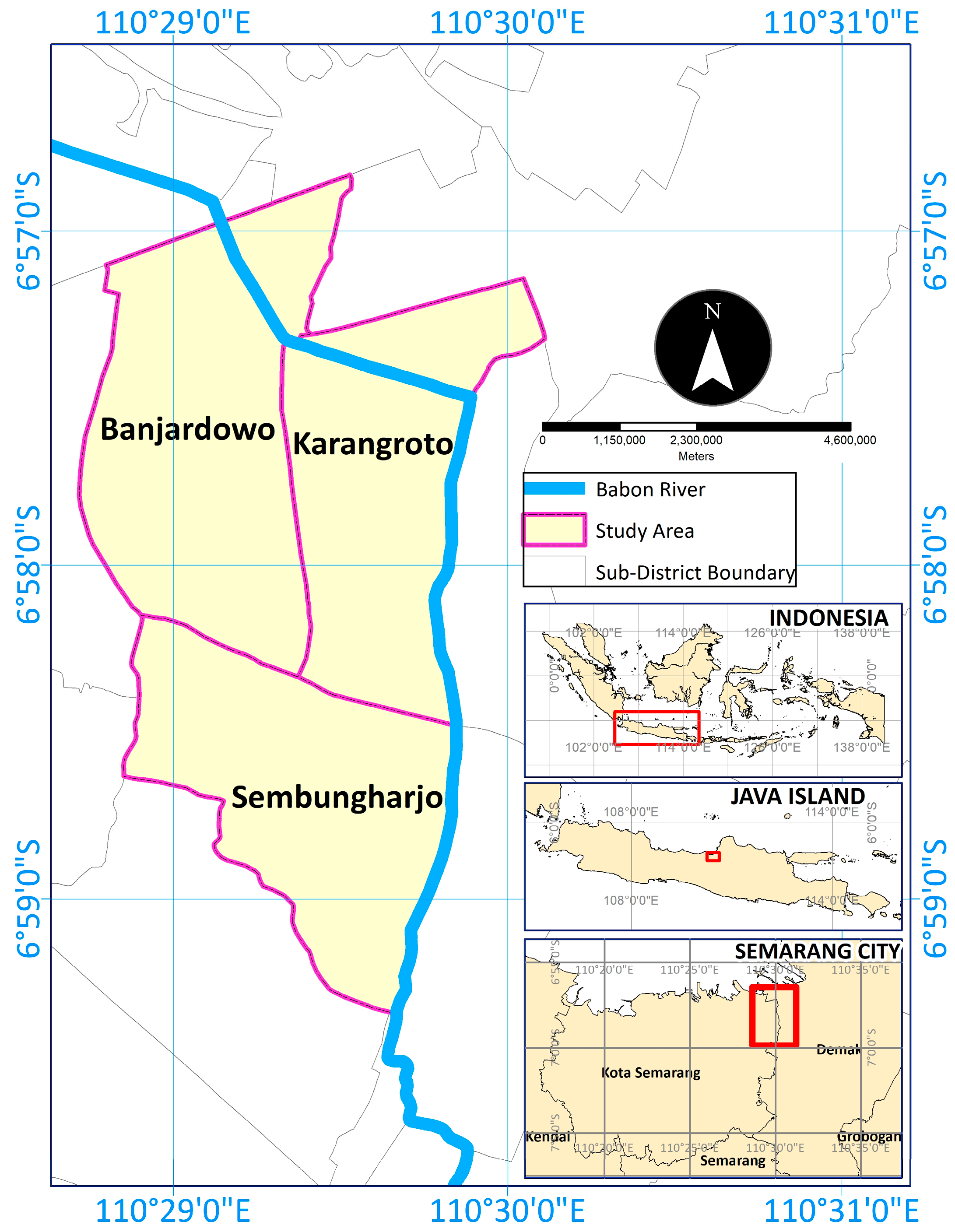
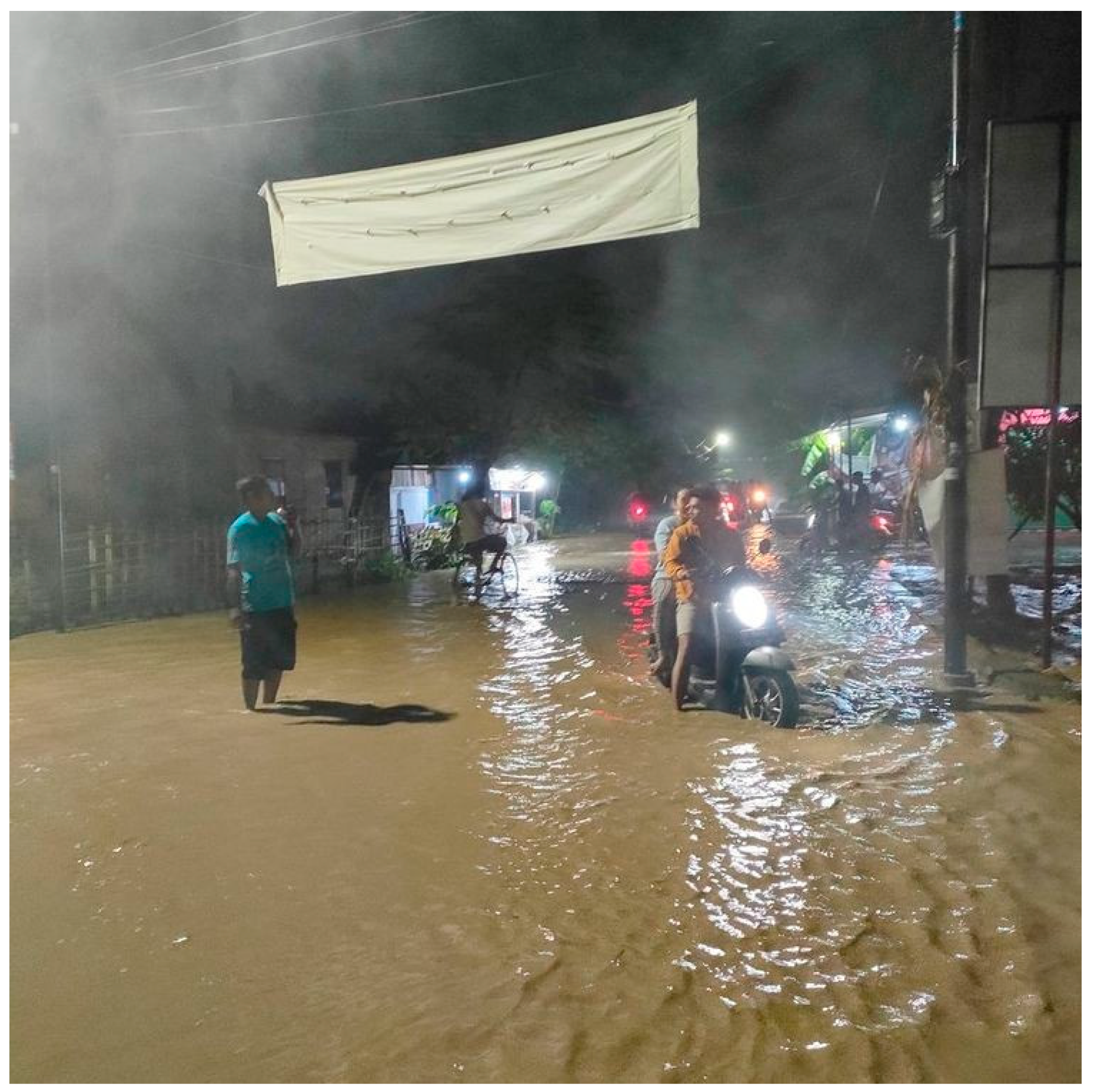
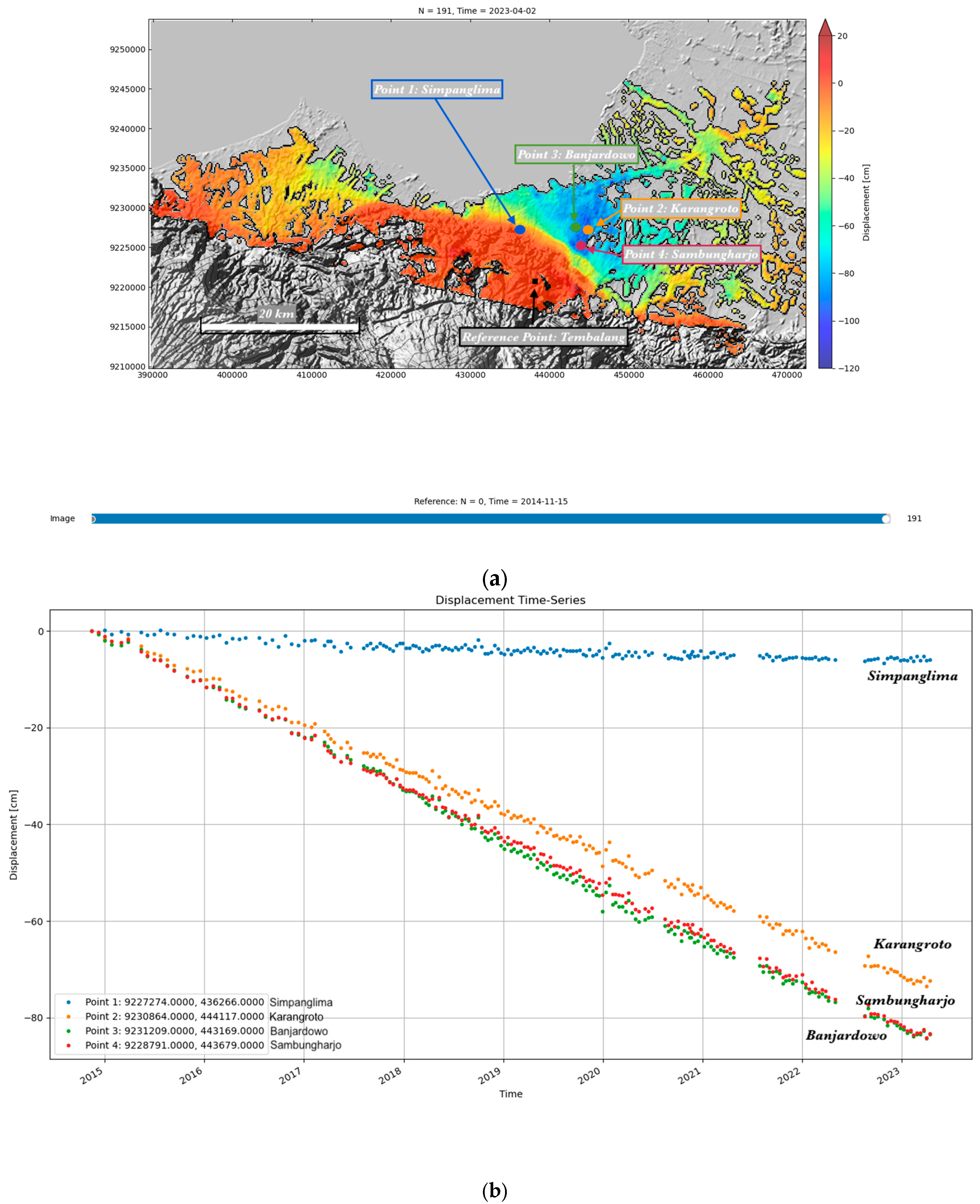
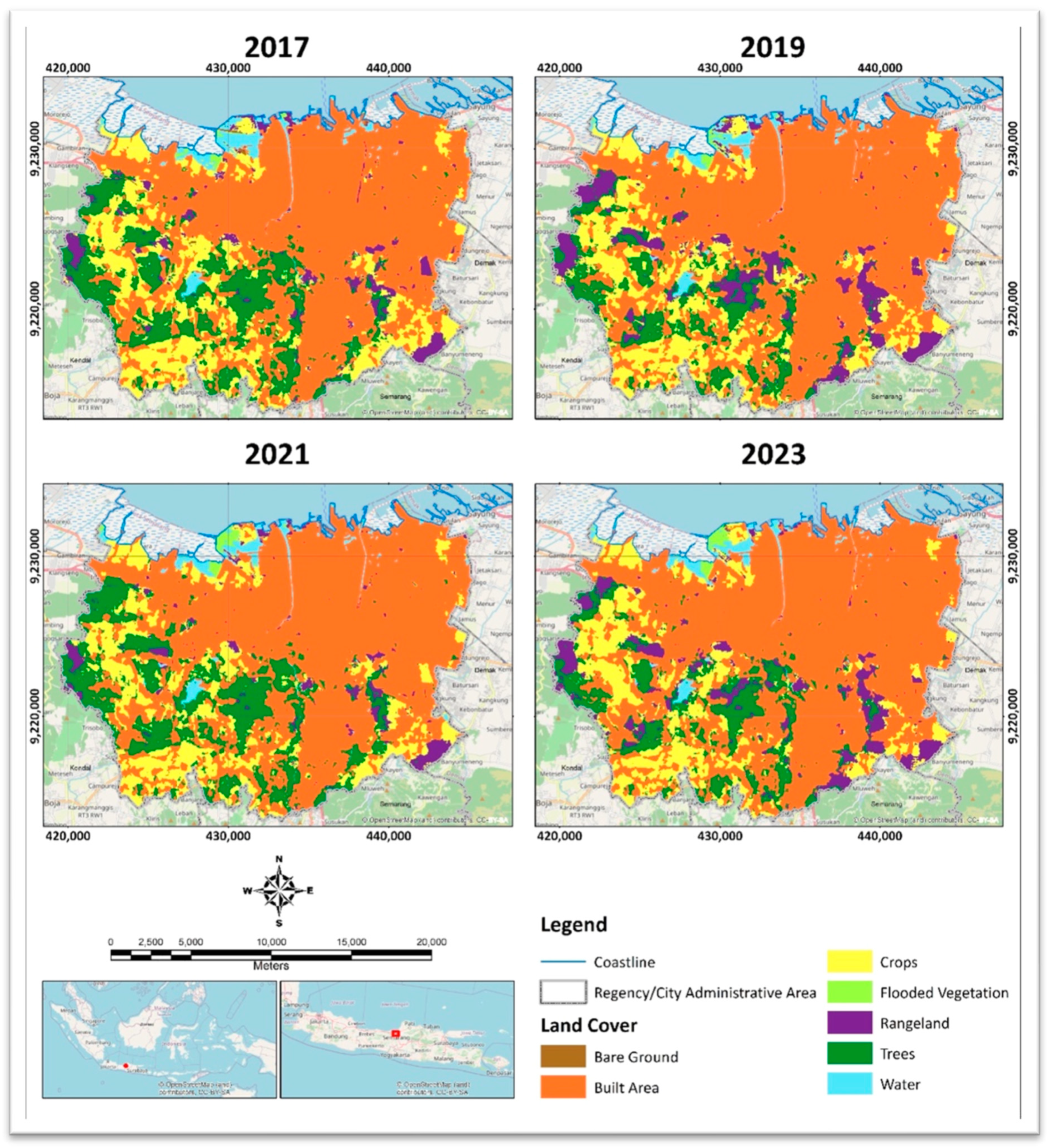
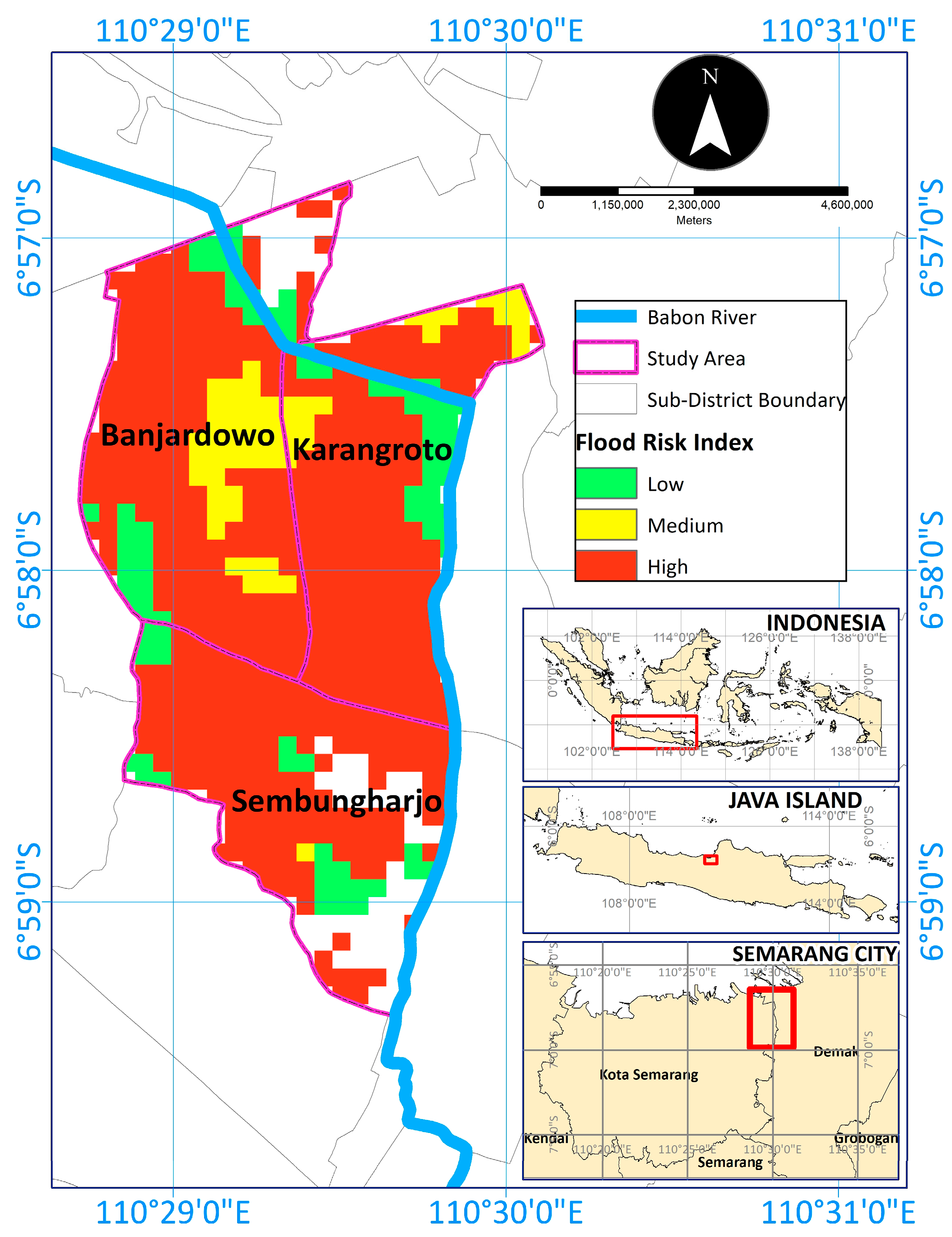
| Feature | In-Depth Interviews | Focus Group Discussions (FGDs) |
|---|---|---|
| Purpose | Understand sub-district-level decision-making on flood and subsidence management. | Capture diverse stakeholder perspectives and collective experiences on flood management challenges. |
| Participant Selection | Purposive and snowball sampling of key informants:
| The diverse mix of local stakeholders from three sub-districts:
|
| Sample Size | >10 interviews, determined by the data saturation principle. | 8–12 participants per group. |
| Location/Duration | 40–60 min semi-structured interviews using a guide with open-ended questions. Audio-recorded with informed consent. | 60–90 min semi-structured discussions exploring themes like polder effectiveness and flood preparedness. Audio-recorded with informed consent. |
| Procedure | Inductive thematic analysis with iterative coding and established inter-coder reliability. | Thematic analysis to identify recurring themes and nuances, with members checking for validation. |
| Data Analysis | Findings were validated through expert discussion with academics and administrators from BRIN and Universitas Indonesia. | Triangulated with systematic field observation notes for contextual depth and enhanced validity. |
| Validation | Strict adherence to informed consent, confidentiality, and the participant’s right to withdraw. | Strict adherence to “Do No Harm” principles, including informed consent, voluntary participation, and guaranteed anonymity. |
| Ethical Considerations | Understand sub-district-level decision-making on flood and subsidence management. | Capture diverse stakeholder perspectives and collective experiences on flood management challenges. |
| Adaptation and Mitigation Measures | Objectives | Goals | Type of Program |
|---|---|---|---|
| Rainwater harvesting | Optimizing surface water utilization to reduce the use of groundwater | Continuously provide clean water during rainy and dry seasons | Pilot project (short term) |
| Building new water storage consists of ponds and retention basins | To retain the surface water (controlling surface water and controlling overflow during the rainy season) | To decrease runoff, land subsidence, and water intrusion | Led by PDAM (state-owned water company) (medium-term project) |
| “Watershed, water reservoir, and basic water resource conservation” | Increase basic water management performance | “Water provision for all sectors, including agriculture” | Medium-term |
| Flood control: water pumps, embankment. Polder (in addition to retentions and reservoirs) | Mitigating floods | Including the normalization of Banjir Kanal east and west, manage floods, reduce floods | Medium-term, started in 2019 |
| Rainwater harvesting | Optimizing surface water utilization to reduce the use of groundwater | Continuously provide clean water during rainy and dry seasons | Pilot project (short term) |
| Building new water storage consists of ponds and retention basins | To retain the surface water (controlling surface water and controlling overflow during the rainy season) | To decrease runoff, land subsidence, and water intrusion | Led by PDAM (state-owned water company) (medium-term project) |
| Aspects | Key Issues |
|---|---|
| Technical | The recurrent flooding issue is primarily attributed to ineffective government programs. These programs are inadequate and lack consistency in addressing regional problems. For example, elevating roadways intended to mitigate flooding has inadvertently led to increased water runoff into residential areas, exacerbating the flooding problem. Additionally, relocating residents to areas more prone to flooding has increased their vulnerability to severe flood hazards compared to their previous locations. Such relocations have heightened the population’s susceptibility to floods, making their new areas more hazardous. |
| Institutional | Flood management at the research sites often conflicts with national and local interests. The central government’s primary role is safeguarding critical national infrastructure, such as highways, crucial for connecting Java Island. However, the pace of national programs often exceeds the capacity of local infrastructure development, leading to misalignment and ineffective flood management. |
| Organizational Capacities | The lack of clear flood control strategies reflects inadequate institutional capacity. For instance, while elevating roads is intended to prevent flooding, it fails to address the root cause of land subsidence: excessive groundwater extraction. This condition indicates a need for a more comprehensive approach to flood management that includes tackling the underlying causes of subsidence. |
| Responses to Land Subsidence (Realized as Flood) | Implementation |
|---|---|
| Protect | Flood controls: retaining wall, water channel, river dredging |
| Retreat | Relocation, evictions |
| Accommodate | Elevating the roads, elevating floors, planting trees |
Disclaimer/Publisher’s Note: The statements, opinions and data contained in all publications are solely those of the individual author(s) and contributor(s) and not of MDPI and/or the editor(s). MDPI and/or the editor(s) disclaim responsibility for any injury to people or property resulting from any ideas, methods, instructions or products referred to in the content. |
© 2025 by the authors. Licensee MDPI, Basel, Switzerland. This article is an open access article distributed under the terms and conditions of the Creative Commons Attribution (CC BY) license (https://creativecommons.org/licenses/by/4.0/).
Share and Cite
Dalimunthe, S.A.; Santosa, B.H.; Surtiari, G.A.K.; Reksa, A.F.A.; Ardiyanto, R.; Putiamini, S.; Agustan, A.; Ito, T.; Purwana, R. Subsiding Cities: A Case Study of Governance and Environmental Drivers in Semarang, Indonesia. Urban Sci. 2025, 9, 266. https://doi.org/10.3390/urbansci9070266
Dalimunthe SA, Santosa BH, Surtiari GAK, Reksa AFA, Ardiyanto R, Putiamini S, Agustan A, Ito T, Purwana R. Subsiding Cities: A Case Study of Governance and Environmental Drivers in Semarang, Indonesia. Urban Science. 2025; 9(7):266. https://doi.org/10.3390/urbansci9070266
Chicago/Turabian StyleDalimunthe, Syarifah Aini, Budi Heru Santosa, Gusti Ayu Ketut Surtiari, Abdul Fikri Angga Reksa, Ruki Ardiyanto, Sepanie Putiamini, Agustan Agustan, Takeo Ito, and Rachmadhi Purwana. 2025. "Subsiding Cities: A Case Study of Governance and Environmental Drivers in Semarang, Indonesia" Urban Science 9, no. 7: 266. https://doi.org/10.3390/urbansci9070266
APA StyleDalimunthe, S. A., Santosa, B. H., Surtiari, G. A. K., Reksa, A. F. A., Ardiyanto, R., Putiamini, S., Agustan, A., Ito, T., & Purwana, R. (2025). Subsiding Cities: A Case Study of Governance and Environmental Drivers in Semarang, Indonesia. Urban Science, 9(7), 266. https://doi.org/10.3390/urbansci9070266








